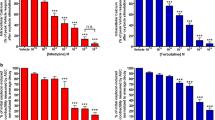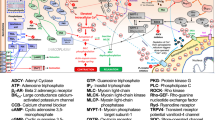Abstract
Many pharmacological agents have been investigated to manage preterm labor; we postulate that a combination of tocolytic drugs may achieve a better effect in the prevention of uterine contractions without dose-dependent adverse effects. The aim of this study was to evaluate the inhibitory effect of dual combinations of tocolytics in vitro. Human myometrium was obtained during elective cesarean sections (term without labor; n = 40). Myometrial strips were placed in organ baths for the measurement of isometric tension. Contractile activity was induced by oxytocin (10−8 mol/L), then a concentration-response curve to single or dual combinations of tocolytics was started. All studied tocolytics (nifedipine, ritodrine, nitroglycerin, atosiban, and NS-1619), when used alone, significantly inhibited myometrial contractions. When combined, nifedipine plus ritodrine produced a significantly greater inhibition of contractility than each drug alone in the midrange of concentrations. The combination of nifedipine plus nitroglycerin or nifedipine plus atosiban produced a significantly greater inhibition than nitroglycerin or atosiban alone but not greater than nifedipine. The combination of nifedipine plus NS-1619 (Ca+2-activated K+ [BKCa] channel opener) reduced the inhibitory effect of each drug. We concluded that a selected combination of tocolytics (nifedipine plus ritodrine) produced a significantly greater inhibitory effect on contractility than each drug alone at intermediate concentrations. Thus, specific combinations of tocolytics with different intracellular signaling pathways may have a synergic effect constituting a provocative new option for preterm labor treatment.
Similar content being viewed by others
References
Barros FC, Papageorghiou AT, Victora CG, et al. International Fetal and Newborn Growth Consortium for the 21st Century. The distribution of clinical phenotypes of preterm birth syndrome: implications for prevention. JAMA Pediatr. 2015;169(3):220–229.
Saigal S, Doyle LW. An overview of mortality and sequelae of preterm birth from infancy to adulthood. Lancet. 2008;371(9608):261–269.
Goldenberg RL, Culhane JF, Iams JD, Romero R. Epidemiology and causes of preterm birth. Lancet. 2008;371(9606):75–84.
Norwitz ER, Robinson JN, Challis JR. The control of labor. N Engl J Med. 1999;341(9):660–666.
Akerlund M, Carlsson AM, Melin P, Trojnar J. The effect on the human uterus of two newly developed competitive inhibitors of oxytocin and vasopressin. Acta Obstet Gynecol Scand. 1985;64(6):499–504.
Lees C, Campbell S, Jauniaux E, et al. Arrest of preterm labour and prolongation of gestation with glyceryl trinitrate, a nitric oxide donor. Lancet. 1994;343(8909):1325–1326.
Liu YL, Nwosu UC, Rice PJ. Relaxation of isolated human myometrial muscle by beta2-adrenergic receptors but not beta1-adrenergic receptors. Am J Obstet Gynecol. 1998;179(4):895–898.
Nassar AH, Aoun J, Usta IM. Calcium channel blockers for the management of preterm birth: a review. Am J Perinatol. 2011;28(1):57–66.
Olesen SP, Munch E, Moldt P, Drejer J. Selective activation of Ca(2+)-dependent K+ channels by novel benzimidazolone. Eur J Pharmacol. 1994;251(1):53–59.
Berkman ND, Thorp JM Jr, Lohr KN, et al. Tocolytic treatment for the management of preterm labor: a review of the evidence. Am J Obstet Gynecol. 2003;188(6):1648–1659.
Petousis S, Margioula-Siarkou C, Kalogiannidis I. Effectiveness of tocolytic agents on prevention of preterm delivery, neonatal morbidity, and mortality: is there a consensus? A review of the literature. Obstet Gynecol Surv. 2016;71(4):243–252.
Carvajal JA. Parto Prematuro. In: Pérez Sánchez A, Donoso E, eds. Obstetricia. Cuarta Edición ed. Santiago, CL: Editorial Mediterráneo Ltda; 2011:717–744.
Doret M, Mellier G, Gaucherand P, et al. The in vitro effect of dual combinations of ritodrine, nicardipine an atosiban on contractility of pregnant rat myometrium. BJOG. 2003;110(8):731–734.
Kuc P, Laudanski P, Pierzynski P, Laudanski T. The effect of combined tocolysis on in vitro uterine contractility in preterm labour. Adv Med Sci. 2011;56(1):88–94.
Haas DM, Caldwell DM, Kirkpatrick P, McIntosh JJ, Welton NJ. Tocolytic therapy for preterm delivery: systematic review and network meta-analysis. BMJ. 2012;345:e6226.
Carvajal JA, Buhimschi IA, Thompson LP, Aguan K, Weiner CP. Chorion releases a factor that inhibits oxytocin-stimulated myo-metrial contractility in the pregnant guinea pig. Hum Reprod. 2001;16(4):638–643.
Chiossi G, Costantine MM, Betancourt A, et al. Does sildenafil citrate affect myometrial contractile response to nifedipine in vitro? Am J Obstet Gynecol. 2010;252(3):252.e1-e5.
David M, Hamann C, Chen FC, Bruch L, Lichtenegger W. Comparison of the relaxation effect in vitro of nitroglycerin vs. fenoterol on human myometrial strips. J Perinat Med. 2000;28(3):232–242.
Sakakibara T, Inoue Y, Uzue S, et al. Diversity of inhibitory responses to beta2-stimulants shown by term-pregnant human myometria in vitro is partly due to differences in receptor density. Am J Obstet Gynecol. 2002;186(5):997–1004.
Khan RN, Smith SK, Ashford ML. Contribution of calcium-sensitive potassium channels to NS1619-induced relaxation in human pregnant myometrium. Hum Reprod. 1998;13(1):208–213.
Moynihan AT, Smith TJ, Morrison JJ. The relaxant effect of nifedipine in human uterine smooth muscle and the BK(Ca) channel. Am J Obstet Gynecol. 2008;237(2):237.e1-e8.
Carvajal JA, Germain AM, Huidobro-Toro JP, Weiner CP. Molecular mechanism of cGMP-mediated smooth muscle relaxation. J Cell Physiol. 2000;184(3):409–420.
Yallampalli C, Dong YL, Gangula PR, Fang L. Role and regulation of nitric oxide in the uterus during pregnancy and parturition. J Soc Gynecol Investig. 1998;5(2):58–67.
Duckitt K, Thornton S, O’Donovan OP, Dowswell T. Nitric oxide donors for treating preterm labour. Cochrane Database Syst Rev. 2014;(5):CD002860.
Husslein P, Cabero Roura L, Dudenhausen JW, et al. Atosiban versus usual care for the management of preterm labor. J Perinat Med. 2007;35(4):305–313.
Saez V, Germain AM, Carvajal JA. Atosiban, perspectivas sobre el manejo etiológico del parto prematuro. Rev Chil Obstet Gine-col. 2002;67(3):249–255.
Flenady V, Reinebrant HE, Liley HG, Tambimuttu EG, Papatso-nis DN. Oxytocin receptor antagonists for inhibiting preterm labour. Cochrane Database Syst Rev. 2014;(6):CD004452.
Group EAS. The oxytocin antagonist atosiban versus the beta-agonist terbutaline in the treatment of preterm labor a randomized, double-blind, controlled study. Acta Obstet Gynecol Scand. 2001;80(5):413–422.
Moutquin JM, Sherman D, Cohen H, et al. Double-blind, randomized, controlled trial of atosiban and ritodrine in the treatment of preterm labor: a multicenter effectiveness and safety study. Am J Obstet Gynecol. 2000;182(5):1191–1199.
Salim R, Garmi G, Nachum Z, Zafran N, Baram S, Shalev E. Nifedipine compared with atosiban for treating preterm labor: a randomized controlled trial. Obstet Gynecol. 2012;120(6):1323–1331.
Lorca RA, Prabagaran M, England SK. Functional insights into modulation of BKCa channel activity to alter myometrial contractility. Front Physiol. 2014;5:289.
Miller C. An overview of the potassium channel family. Genome Biol. 2000;1(4):REVIEWS0004.
Yamamura H, Ohi Y, Muraki K, Watanabe M, Imaizumi Y. BK channel activation by NS-1619 is partially mediated by intracel-lular Ca2+ release in smooth muscle cells of porcine coronary artery. Br J Pharmacol. 2001;132(4):828–834.
Vasudevan NT, Mohan ML, Goswami SK, Naga Prasad SV. Regulation of beta-adrenergic receptor function: an emphasis on receptor resensitization. Cell Cycle. 2011;10(21):3684–3691.
Yuan W, Lopez Bernal A. Cyclic AMP signalling pathways in the regulation of uterine relaxation. BMC Pregnancy Childbirth. 2007;7(suppl 1):S10.
Hubinont C, Debieve F. Prevention of preterm labour: 2011 update on tocolysis. J Pregnancy. 2011;2011:941057.
Yaju Y, Nakayama T. Effectiveness and safety of ritodrine hydro-chloride for the treatment of preterm labour: a systematic review. Pharmacoepidemiol Drug Saf. 2006;15(11):813–822.
Neilson JP, West HM, Dowswell T. Betamimetics for inhibiting preterm labour. Cochrane Database Syst Rev. 2014;(2): CD004352.
Flenady V, Wojcieszek AM, Papatsonis DN, et al. Calcium channel blockers for inhibiting preterm labour and birth. Cochrane Database Syst Rev. 2014;(6):CD002255.
Kim MJ, Hwang I, Bae JY, Seong WJ. The influence of ritodrine alone or in combination with nifedipine on maternal cardiovascular side effects and pregnancy outcomes. Clin Exp Obstet Gynecol. 2014;41(5):537–540.
Vogel JP, Nardin JM, Dowswell T, West HM, Oladapo OT. Combination of tocolytic agents for inhibiting preterm labour. Cochrane Database Syst Rev. 2014;(7):CD006169.
Brown RG, MacIntyre DA. Calcium channel blockers are effective as first line for tocolysis in the management of preterm labour. Evid Based Med. 2014;214(6):214.
Author information
Authors and Affiliations
Corresponding author
Rights and permissions
About this article
Cite this article
Carvajal, J.A., Zambrano, M.J., Theodor, N.M. et al. The Synergic In Vitro Tocolytic Effect of Nifedipine Plus Ritodrine on Human Myometrial Contractility. Reprod. Sci. 24, 635–640 (2017). https://doi.org/10.1177/1933719116667221
Published:
Issue Date:
DOI: https://doi.org/10.1177/1933719116667221




